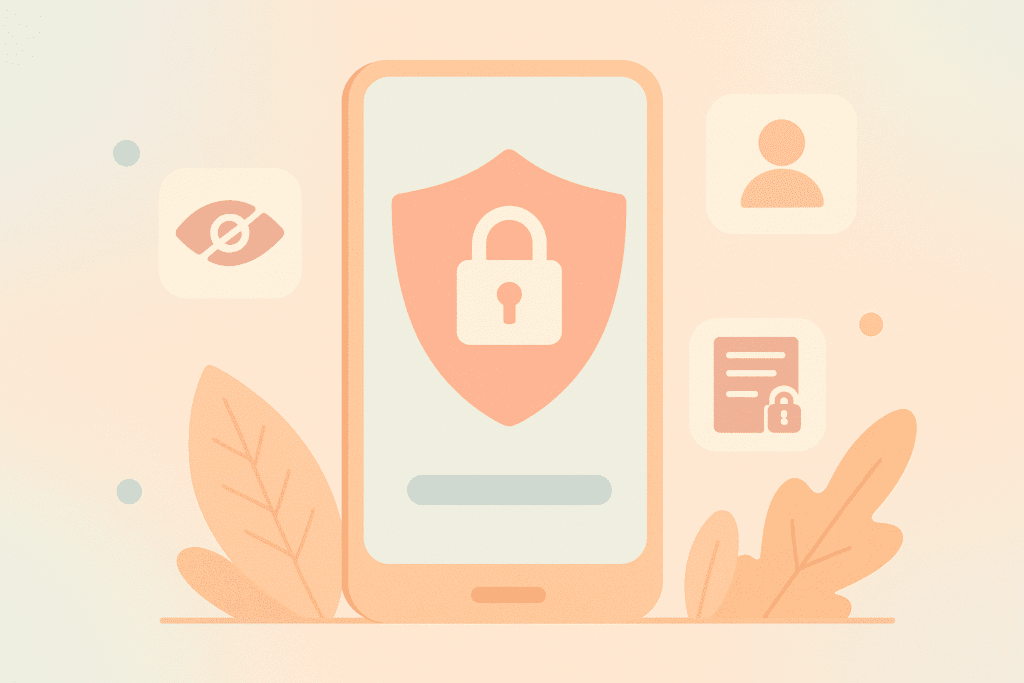In 2025, privacy is no longer just a feature — it’s a fundamental expectation in mobile app development. As users become more aware of how their personal data is collected and shared, developers must prioritize privacy-first design to build trust, ensure compliance, and maintain competitiveness in a rapidly evolving digital ecosystem.

The Rise of Privacy Awareness
Over the past decade, the conversation around privacy has shifted dramatically. Global regulations such as the GDPR (General Data Protection Regulation) in Europe, CCPA (California Consumer Privacy Act) in the U.S., and Indonesia’s PDP Law have empowered users to demand transparency and control over their data. As a result, companies that fail to integrate privacy into their app design risk losing user trust — and even face serious legal penalties.
In 2025, digital consumers are smarter and more selective. They expect apps to explain why certain permissions are requested, how data is stored, and who has access to it. Privacy is no longer a “nice-to-have”; it’s a key factor influencing whether a user installs — or uninstalls — an app.
What Is Privacy-First Design?
Privacy-first design means placing user data protection at the core of every stage of app development — from initial concept to deployment and updates. It’s a proactive approach that anticipates privacy risks and mitigates them before they affect users.
This philosophy aligns closely with the concept of Privacy by Design, which includes seven key principles:
- Proactive, not reactive — prevent privacy issues before they happen.
- Privacy as the default setting — users shouldn’t need to opt-in to protection.
- Embed privacy into the design — make it integral, not optional.
- Ensure full functionality — privacy and usability must coexist.
- End-to-end security — protect data throughout its lifecycle.
- Transparency — communicate openly about data practices.
- User-centric — prioritize user control and trust.
Why Privacy-First Design Matters in 2025
In 2025, privacy is not just about compliance — it’s about survival. Here are several reasons why privacy-first development is essential for app developers and businesses:
1. Building User Trust
Users are increasingly cautious about which apps they download. When privacy is clearly communicated and transparently handled, users feel safer sharing data. Trust directly translates into higher retention rates, positive reviews, and organic growth.
2. Meeting Global Regulations
Regulatory landscapes are expanding. Governments worldwide are introducing stricter rules to protect digital citizens. By adopting privacy-first design early, developers ensure compliance with laws like GDPR, CCPA, and new AI-related privacy acts — avoiding costly fines and reputation damage.
3. Preventing Data Breaches
Data breaches are becoming more sophisticated. A single vulnerability can compromise thousands of users’ data, leading to lawsuits and massive financial losses. By designing with privacy in mind — using encryption, anonymization, and secure APIs — developers can minimize these risks.
4. Enhancing User Experience
Privacy-first doesn’t mean complex user flows. On the contrary, clear consent dialogs, customizable permissions, and transparent policies enhance the user experience. A privacy-respecting app feels professional and trustworthy — key factors for user satisfaction.
5. Supporting Ethical AI Integration
As AI continues to shape mobile experiences in 2025, privacy-first principles ensure that machine learning models are trained and deployed responsibly. Ethical AI respects user data boundaries and prevents misuse or bias in automated decisions.
Key Strategies for Privacy-First Mobile App Development
Implementing privacy-first design isn’t just about adding encryption; it requires a holistic development strategy. Below are practical steps developers can follow:
1. Minimize Data Collection
Collect only what is necessary. Avoid asking for permissions that your app doesn’t absolutely need. The less data you store, the less risk you carry.
2. Use Secure Data Storage and Transmission
Encrypt all sensitive information, both in transit and at rest. Use HTTPS, SSL/TLS, and secure cloud storage solutions. Never store passwords in plain text.
3. Implement Transparent Consent Management
Inform users what data you collect and why. Provide clear consent dialogs that allow users to make informed decisions. Give them the ability to revoke permissions anytime.
4. Regularly Audit and Test for Vulnerabilities
Perform regular privacy audits and penetration tests. Vulnerabilities often appear after updates or third-party integrations. Continuous testing ensures your app stays secure over time.
5. Offer Privacy Controls to Users
Let users customize privacy settings, delete their data, or manage tracking preferences directly within the app. Empowering users increases their confidence and satisfaction.
6. Keep Third-Party SDKs in Check
Many data leaks happen through third-party SDKs used for analytics or ads. Always verify that external libraries comply with privacy standards before integration.
Examples of Privacy-First Apps in 2025
Some global companies have already set benchmarks in privacy-first mobile development:
- Signal – Known for its end-to-end encrypted messaging and open-source transparency.
- DuckDuckGo – A privacy-focused browser and search app that doesn’t track users.
- Apple iOS Apps – Apple enforces strong privacy policies and app tracking transparency (ATT) across its ecosystem.
- Brave Browser – Blocks trackers and ads by default, giving users full control.
These examples prove that prioritizing privacy doesn’t mean sacrificing performance or profit — it’s a competitive advantage that attracts loyal, privacy-conscious users.
The Future of Privacy in Mobile App Development
By 2025 and beyond, the concept of privacy-first app development will evolve alongside technologies like blockchain, zero-knowledge proofs, and federated learning. These innovations will allow developers to process data securely without exposing sensitive information.
Developers who adopt privacy-first thinking today are setting the foundation for long-term sustainability. In the era of data-driven decisions and AI personalization, those who respect user privacy will lead the next generation of trusted digital products.
Conclusion
Privacy-first design is no longer optional in 2025 — it’s essential. Mobile app developers must embed privacy into every stage of their design process, from architecture to analytics. Doing so not only protects users but also strengthens the app’s credibility, compliance, and longevity in an increasingly privacy-aware market.
Whether you’re developing a startup app or scaling a global product, privacy-first design should be your default mindset — because in 2025, the most trusted apps are the ones that protect their users first.

